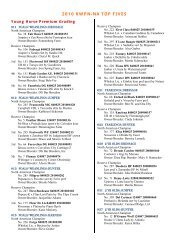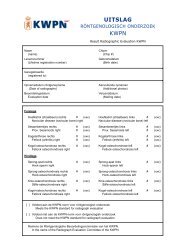Download PDF - KWPN
Download PDF - KWPN
Download PDF - KWPN
You also want an ePaper? Increase the reach of your titles
YUMPU automatically turns print PDFs into web optimized ePapers that Google loves.
ever, interfere with the formation and<br />
development of a functional CL, and<br />
be detrimental to the establishment of<br />
a normal pregnancy (Troedsson et al,<br />
2001). It appears that the efficacy and<br />
safety aspects favor oxytocin over<br />
prostaglandins in most cases. A combination<br />
of post-breeding uterine lavage<br />
and oxytocin treatment is preferred by<br />
some practitioners.<br />
Management after breeding<br />
Progesterone is the hormone responsible<br />
for maintenance of pregnancy in<br />
the mare. Progesterone keeps the mare<br />
out of heat, ensure that the cervix is<br />
closed, and prevent the uterus from<br />
expelling the fetus prematurely.<br />
During the first 80-100 days of pregnancy,<br />
progesterone is produced by the<br />
corpus luteum (CL), which is the<br />
structure on the ovary that is formed<br />
after ovulation. During this time,<br />
insufficient release of progesterone<br />
from a defective CL could result in the<br />
loss of a normal embryo. After 80 days<br />
of gestation, progesterone is also produced<br />
by the fetal/placental unit. After<br />
this time of the pregnancy, a viable<br />
fetus will ensure that enough progesterone<br />
is produced to maintain pregnancy.<br />
Determination of circulating<br />
plasma concentrations of progesterone<br />
is used by many practitioners to identify<br />
mares at risk of losing their pregnancy<br />
as a result of luteal dysfunction.<br />
However, progesterone is released<br />
from the CL in a pulsatile pattern, and<br />
hormone analysis from a single blood<br />
sample does not reflect the circulating<br />
blood concentrations over time. In<br />
addition, primary luteal insufficiency<br />
as a cause of pregnancy loss in horses<br />
has not been supported by scientific<br />
data. A normal CL produces enough<br />
progesterone to maintain a pregnancy.<br />
There are however, some predisposing<br />
factors that may result in a secondary<br />
failure of the CL to produce sufficient<br />
progesterone to maintain pregnancy.<br />
Systemic disease processes such as<br />
endotoxemia or local inflammatory<br />
conditions in the mare may result in<br />
the release of PGF 2 α which may be<br />
detrimental to the CL. Pregnant mares<br />
that were experimentally treated with<br />
endotoxin, lost their pregnancies<br />
(Daels et al, 1991). A more recent<br />
study showed that the CL in mares that<br />
were treated with repeated doses of<br />
PGF 2 α during the 2 first days after<br />
ovulation failed to secrete normal levels<br />
of progesterone during the first 5<br />
days after ovulation (Troedsson et al,<br />
2001). However, blood progesterone<br />
concentrations were similar to control<br />
mares at 14 days after ovulation. The<br />
delayed formation and development of<br />
the CL in treated mares were detrimental<br />
to pregnancy at 14 days<br />
(Troedsson et al, 2001). Problem<br />
mares that are thought to benefit from<br />
being supplemented with altrenogest<br />
(Regumate) during pregnancy should<br />
therefore already be started on the<br />
treatment two days after ovulation. If a<br />
mare develops systemic disease with<br />
signs of endotoxemia, she should be<br />
supplemented with progesterone. If<br />
supplemented with progesterone during<br />
early gestation, there is no benefit<br />
for treatment beyond 100-120 days,<br />
since the fetal/placental unit now has<br />
taken over the production of progesterone.<br />
Monitoring during pregnancy<br />
Problem mares are more likely<br />
than reproductively sound mares to<br />
experience embryonic loss and abortion.<br />
It is therefore, important to<br />
repeatedly monitor the viability and<br />
development of the embryo/fetus in<br />
these mares. Normal embryonic development<br />
should be closely monitored<br />
before the formation of endometrial<br />
cups, so that the mare can be bred<br />
without further delay if she is found to<br />
have lost her pregnancy. Hormonally<br />
active endometrial cups are formed at<br />
day 37 after fertilization, resulting in<br />
the secretion of eCG and the development<br />
of secondary CL. The endometrial<br />
cups will continue to secrete eCG<br />
up to ~150 days after fertilization even<br />
if the pregnancy is lost, which makes it<br />
difficult to bring the mare back to heat<br />
during the current breeding season.<br />
Mares that lose their pregnancies after<br />
the formation of endometrial cups<br />
should be identified and prepared for<br />
the next season. Identification of these<br />
mares before the end of November<br />
will allow them to be treated for possible<br />
uterine infections, put under an<br />
artificial light protocol for 60 days and<br />
be ready for breeding early during the<br />
next breeding season.<br />
Problem mares may be more likely<br />
to develop placentitis and abortion as a<br />
Continued on Page 9.<br />
Page 7 • Newsletter
















